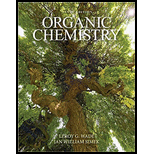
ORGANIC CHEMISTRY
9th Edition
ISBN: 9780134645704
Author: WADE AND SIMEK
Publisher: PEARSON
expand_more
expand_more
format_list_bulleted
Question
Chapter 26.3, Problem 26.10P
Interpretation Introduction
Interpretation:
The structures of isotactic poly (acrylonitirile) and syndiotactic polystyrene are to be drawn.
Concept introduction:
The
Polystyrene is a polymer of styrene. Styrene or vinylbenzene is an organic compound with a molecular formula
Expert Solution & Answer
Want to see the full answer?
Check out a sample textbook solution
Students have asked these similar questions
1. Which one(s) of these can be oxidized with CrO3 ?
(could be more than one)
a) triphenylmethanol
b) 2-pentanol
c) Ethyl alcohol
d)
CH3
2. Write in all the product(s) of this reaction. Label them
as "major" or "minor".
2-methyl-2-hexanol
H2SO4, heat
3) Determine if the pairs are constitutional isomers, enantiomers, diastereomers, or mesocompounds.
(4 points)
In the decomposition reaction in solution B → C, only species C absorbs UV radiation, but neither B nor the solvent absorbs. If we call At the absorbance measured at any time, A0 the absorbance at the beginning of the reaction, and A∞ the absorbance at the end of the reaction, which of the expressions is valid? We assume that Beer's law is fulfilled.
Chapter 26 Solutions
ORGANIC CHEMISTRY
Ch. 26.2A - Show the intermediate that would result if the...Ch. 26.2A - Prob. 26.2PCh. 26.2A - Prob. 26.3PCh. 26.2B - Prob. 26.4PCh. 26.2B - Prob. 26.5PCh. 26.2B - Chain branching occurs in cationic polymerization...Ch. 26.2C - Prob. 26.7PCh. 26.2C - Prob. 26.8PCh. 26.2C - Chain branching is not as common with anionic...Ch. 26.3 - Prob. 26.10P
Ch. 26.5 - Prob. 26.11PCh. 26.6 - Prob. 26.12PCh. 26.7A - Prob. 26.13PCh. 26.7B - Prob. 26.14PCh. 26.7B - Prob. 26.15PCh. 26.7C - a. Propose a mechanism for the reaction of...Ch. 26.7C - Prob. 26.17PCh. 26.7D - Prob. 26.18PCh. 26.7D - Prob. 26.19PCh. 26.7D - Prob. 26.20PCh. 26 - Prob. 26.21SPCh. 26 - Prob. 26.22SPCh. 26 - Poly(trimethylene carbamate) is used in...Ch. 26 - Prob. 26.24SPCh. 26 - Urylon fibers are used in premium fishing nets...Ch. 26 - Prob. 26.26SPCh. 26 - Prob. 26.27SPCh. 26 - Polyoxymethylene (polyformaldehyde) is the tough,...Ch. 26 - Prob. 26.29SPCh. 26 - Prob. 26.30SPCh. 26 - Prob. 26.31SPCh. 26 - Prob. 26.32SPCh. 26 - Prob. 26.33SPCh. 26 - Prob. 26.34SPCh. 26 - The polyester named Lactomer is an alternating...Ch. 26 - Prob. 26.36SP
Knowledge Booster
Similar questions
- > You are trying to decide if there is a single reagent you can add that will make the following synthesis possible without any other major side products: 1. ☑ CI 2. H3O+ O Draw the missing reagent X you think will make this synthesis work in the drawing area below. If there is no reagent that will make your desired product in good yield or without complications, just check the box under the drawing area and leave it blank. Click and drag to start drawing a structure. Explanation Check ? DO 18 Ar B © 2025 McGraw Hill LLC. All Rights Reserved. Terms of Use | Privacy Center | Accessibilityarrow_forwardDon't use ai to answer I will report you answerarrow_forwardConsider a solution of 0.00304 moles of 4-nitrobenzoic acid (pKa = 3.442) dissolved in 25 mL water and titrated with 0.0991 M NaOH. Calculate the pH at the equivalence pointarrow_forward
- What is the name of the following compound? SiMe3arrow_forwardK Draw the starting structure that would lead to the major product shown under the provided conditions. Drawing 1. NaNH2 2. PhCH2Br 4 57°F Sunny Q Searcharrow_forward7 Draw the starting alkyl bromide that would produce this alkyne under these conditions. F Drawing 1. NaNH2, A 2. H3O+ £ 4 Temps to rise Tomorrow Q Search H2arrow_forward
arrow_back_ios
SEE MORE QUESTIONS
arrow_forward_ios
Recommended textbooks for you
 Chemistry: Principles and ReactionsChemistryISBN:9781305079373Author:William L. Masterton, Cecile N. HurleyPublisher:Cengage Learning
Chemistry: Principles and ReactionsChemistryISBN:9781305079373Author:William L. Masterton, Cecile N. HurleyPublisher:Cengage Learning Chemistry for Engineering StudentsChemistryISBN:9781337398909Author:Lawrence S. Brown, Tom HolmePublisher:Cengage Learning
Chemistry for Engineering StudentsChemistryISBN:9781337398909Author:Lawrence S. Brown, Tom HolmePublisher:Cengage Learning Introductory Chemistry: An Active Learning Approa...ChemistryISBN:9781305079250Author:Mark S. Cracolice, Ed PetersPublisher:Cengage Learning
Introductory Chemistry: An Active Learning Approa...ChemistryISBN:9781305079250Author:Mark S. Cracolice, Ed PetersPublisher:Cengage Learning Principles of Modern ChemistryChemistryISBN:9781305079113Author:David W. Oxtoby, H. Pat Gillis, Laurie J. ButlerPublisher:Cengage Learning
Principles of Modern ChemistryChemistryISBN:9781305079113Author:David W. Oxtoby, H. Pat Gillis, Laurie J. ButlerPublisher:Cengage Learning Introductory Chemistry: A FoundationChemistryISBN:9781337399425Author:Steven S. Zumdahl, Donald J. DeCostePublisher:Cengage Learning
Introductory Chemistry: A FoundationChemistryISBN:9781337399425Author:Steven S. Zumdahl, Donald J. DeCostePublisher:Cengage Learning

Chemistry: Principles and Reactions
Chemistry
ISBN:9781305079373
Author:William L. Masterton, Cecile N. Hurley
Publisher:Cengage Learning

Chemistry for Engineering Students
Chemistry
ISBN:9781337398909
Author:Lawrence S. Brown, Tom Holme
Publisher:Cengage Learning

Introductory Chemistry: An Active Learning Approa...
Chemistry
ISBN:9781305079250
Author:Mark S. Cracolice, Ed Peters
Publisher:Cengage Learning

Principles of Modern Chemistry
Chemistry
ISBN:9781305079113
Author:David W. Oxtoby, H. Pat Gillis, Laurie J. Butler
Publisher:Cengage Learning

Introductory Chemistry: A Foundation
Chemistry
ISBN:9781337399425
Author:Steven S. Zumdahl, Donald J. DeCoste
Publisher:Cengage Learning